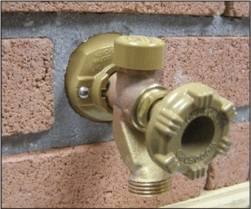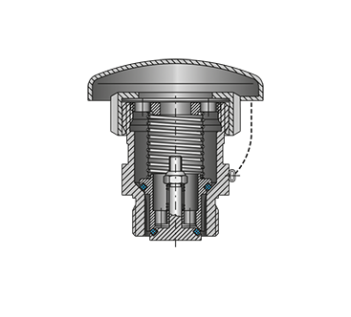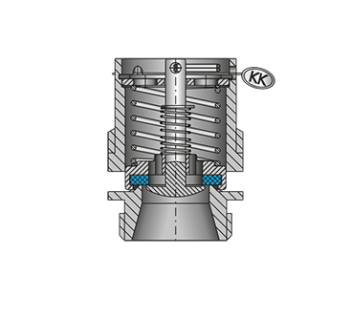
Drinking water, this proecious and important resource, must be properly preserved and protected for the health of the public. This task becomes a shared responsibility, as many people would be affected by contamination of the drinking water network of a municipality or a building.
A simple way to provide quick protection for a potential contamination risk from a hose is to install devices called atmospheric vacuum breakers or hose connection vacuum breakers on the building's exterior and interior faucets.
A vacuum breaker is a backflow preventer device that prevents the back-siphonage of water from a hose into the water system. If, unfortunately, the upstream pressure, i.e. before the location of the vacuum breaker, is reduced, the water after the device escapes through a pipe on top pf the vacuum breaker. This conduit, called a vent, prevents water from returning to the water system. Without protection, this water, possibly contaminated, is now circulating in the building's drinking water pipes. If this water is ingested by an occupant of the facility, serious health consequences could ensue.
A simple example of a situation that clearly demonstrates the importance of a vacuum breaker is the following:
Imagine a tap, in a building, connected to the drinking water network. A hose is then connected to it to fill a bucket of water, containing a detergent product, with the aim of washing a car. A contaminated water solution is then created. If, at the same moment, a pressure drop occurs in the water supply system, either from a nearby pipe break or from heavy use elsewhere in the network, then water from the bucket could be drawn into the drinking water system.
Without a vacuum breaker installed, this contaminated solution could then end up in the building's water pipes or those of the municipality, thus endangering the health of the building's users or that of the public.
Atmospheric Vacuum Breakers (AVB) use atmospheric pressure to slow the reflux of contaminated water into the drinking water system. However, these are not effective against back pressure.

Hose Connection Vacuum Breakers (HCVB) are intended to be installed on the outlet of garden hose faucets. Similar to AVBs these devices resist back siphonage into the drinking water system. An interesting aspect of their use is that they have the advantage of being able to be easily and quickly attached to an existing and functional faucet.

To allow for optimal operation of the device throughout its lifetime, certain actions are recommended.
First of all, it is important to carry out regular checks on the condition of the vacuum breakers. It is simple, each time they are used, to ensure visually that no breakage, corrosion or excessive accumulation of dirt is present.
When the vacuum breaker is subjected to particular environmental conditions, such as severe periods of cold weather, more regular maintenance should be considered. This involves completely draining the faucet and the vacuum breaker, to prevent any accumulation of water inside the device, or installing an insulating box around the vacuum breaker, to keep temperatures more stable.
In summary, the installation of an atmospheric or hose connection vacuum breaker on the exterior or interior faucets of a building is a preventive initiative in the protection of any drinking water network. These simple devices help maintaining the safe drinking quality of the water, as well as ensuring the health and safety of the community.
Canadian Food Inspection Agency. (2021). Preventing water backflow. Site web de l'Agence canadienne d'inspection des aliments
CSA Group. (2023). CSA B64.10:23/CSA B64.10.1:23 (R2021) Selection and installation of backflow preventers/Maintenance and field testing of backflow preventers. Site web de CSA Group
Régie du bâtiment du Québec. (2023). Installer et vérifier un dispositif anti-refoulement, c'est obligatoire. Site web de la Régie du bâtiment du Québec
Gouvernement du Québec. (2023). Quoi faire avant, pendant et après une urgence ou un sinistre: Contamination ou pénurie d'eau potable. https://www.quebec.ca/securite-situations-urgence/urgences-sinistres-risques-naturels/quoi-faire-avant-pendant-apres-urgence-sinistre/contamination-ou-penurie-eau-potable
Woodford Manufacturing Company. (n.d.). Modèle 19 - Robinet mural Woodford. Woodford Manufacturing. https://www.woodfordmfg.com/woodford/Wall_Faucet_Pages/Model-19.html
Kieselmann. (n.d.). Vannes casse vide. Site Web. France: Kieselmann. https://www.kieselmann.fr/produits/vannes-de-cuves/vannes-casse-vide/
We use cookies
Respecting your privacy matters to us. We use cookies to personalize our content and facilitate your digital experience. Some cookies may be collected with your consent.
Essential
Essential cookies help make a website usable by enabling basic functions such as page navigation and access to secure areas of the website. The website cannot function properly without these cookies.
Performance
These cookies enable us to analyze navigation on our sites and improve their operation.
Customization
Preference cookies enable a website to remember information that modifies the behavior or appearance of the site, such as your preferred language or the region you are in.
Targeted advertising
These cookies help us limit the number of times you see an advertisement, personalize our offers and services according to your centers of interest, measure the effectiveness of an advertising campaign, and so on. They may be shared with our partners.
We use cookies
Respecting your privacy matters to us. We use cookies to personalize our content and facilitate your digital experience. Some cookies may be collected with your consent.